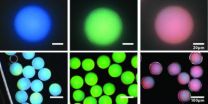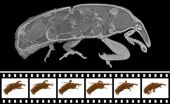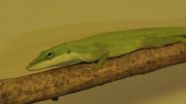(Press-News.org) Cambridge, Mass. – March 14, 2014 – Among the taxidermal specimens in Harvard's Museum of Comparative Zoology, past centuries-old fur coats, arises a flicker of brilliant blue. This is the spangled cotinga. Surprisingly, the cotinga is about as old as everything in the room, but its color is still as dazzling as the day it was brought to the museum. The cotinga—or rather its feathers—achieve this effect through structural color.
Unlike color that we usually think of, which arises from paints and dyes absorbing certain wavelengths of light and reflecting the remainder, structural color is created when an object's very nanostructure amplifies a specific wavelength. Cells in the cotinga's feathers have a series of tiny pores spaced just right so that blues (and not much of anything else) are reflected back to our eyes. Because of this, if the feathers were thoroughly pulverized, the formation of pores and therefore the color would be lost. It also means that the same color could be produced from an entirely different material, if one could recreate the same pattern made by the feathers' pores.
Researchers led by Vinothan N. Manoharan at the Harvard School of Engineering and Applied Sciences want to recreate this effect, giving man-made materials structural color. Producing structural color is not easy, though; it often requires a material's molecules to be in a very specific crystalline pattern, like the natural structure of an opal, which reflects a wide array of colors. But the pores on the cotinga's feathers lack a regular order and are therefore a prime target for imitation.
Manoharan's lab has devised a system where microcapsules are filled with a disordered solution of even smaller particles suspended in water. When the microcapsule is partly dried out, it shrinks, bringing the particles closer and closer together. Eventually the average distance between all the particles will give rise to a specific reflected color from the capsule. Shrink the capsule a bit more, and they become another color, and then another.
"There's an average distance between particles, even though there is no ordering in the particles. It's that average distance that is important in determining the color," says Manoharan, Gordon McKay Professor of Chemical Engineering and Professor of Physics at Harvard.
The findings have been published in the journal Angewandte Chemie.
The current project expands on research conducted at Yale University in 2009, which aimed to mimic the cotinga's hue and showed that dried aggregates of solid particles could create blues. Jin-Gyu Park was a postdoctoral researcher there and is now a research associate in Manoharan's group at Harvard SEAS, which specializes in the physics of colloidal suspensions. With Park as lead author, the new paper demonstrates the production of colors across the spectrum, and the new encapsulation system.
The tunable color capsules present interesting technological opportunities, says Manoharan. For example, a whole spectrum of new paints might be created using suspended capsules.
"Right now, the red dye carmine comes from an insect called a cochineal," says Manoharan. "People would like to move away from that because it's very labor-intensive, and getting that color involves harvesting a lot of insects."
Rather than harvesting from nature or preparing specialty chemicals, one for each color, these capsules could provide a universal and direct path to any desired color.
The capsules might also offer a safety advantage. The reason for using natural dyes like carmine is that many synthetic dyes are toxic. The new color capsules can be made with particles of almost any material in the right structural formation, so toxicity can be easily avoided.
Most compelling of all, however, is that some structural colors found in nature can last indefinitely as long as the colored object remains intact.
"Most color you get in paints, coatings or cosmetics, even, comes from the selective absorption and reflection of light. What that means is that the material is absorbing some energy, and that means that over time, the material will fade," says Manoharan.
The sun's energy pummels the molecules in conventional pigments. Eventually, the molecules simply deteriorate and no longer absorb the colors they used to, leading to sun bleaching. Manoharan's group is currently testing their innovation to see if it can create an effectively ageless color.
Electronic display technology—for example, e-readers—might also benefit from this advance. The microcapsules could be used in displays that create pixels with colored particles rather than LEDs, liquid crystals, or black-and-white "electronic ink."
"We think it could be possible to create a full-color display that won't fade over time," says Manoharan. "The dream is that you could have a piece of flexible plastic that you can put graphics on in full color and read in bright sunlight."
The Harvard Office of Technology Development has filed a provisional patent and is working with Manoharan's lab to pursue the commercialization of the color capsule technology.
INFORMATION:
Manoharan's and Park's coauthors were Sofia Magkiriadou, a Ph.D. student in physics at the Harvard Graduate School of Arts and Sciences; Shin-Hyun Kim and Tae Min Choi at the Korea Advanced Institute of Science and Technology; and Young-Seok Kim at Korea Electronics Technology Institute.
This research was supported by an International Collaboration grant from the Ministry of Trade, Industry & Energy of Korea, and by the Harvard Materials Research Science and Engineering Center through the U.S. National Science Foundation (NSF). The work was performed in part at the NSF-supported Center for Nanoscale Systems at Harvard University.
Brighter inks, without pigment
Nanostructured capsules could bring about paints and electronic displays that never fade
2014-03-14
ELSE PRESS RELEASES FROM THIS DATE:
Patients should wait 6 to 12 weeks before driving after shoulder surgery
2014-03-14
NEW ORLEANS--More than 53,000 Americans have total shoulder joint replacement (SJR) surgery each year, and yet the effects of this surgery on a patient's ability to safely drive a vehicle, and the appropriate recovery time before patients should return to driving, have yet to be determined. In a new study, "Driving Performance after Total Shoulder Arthroplasty," presented today at the 2014 Annual Meeting of the American Academy of Orthopaedic Surgeons (AAOS), the driving skills of 28 shoulder replacement patients, with a mean age of 65 ±10 years, were tested at four distinct ...
3-D X-ray film: Rapid movements in real time
2014-03-14
This news release is available in German. How does the hip joint of a crawling weevil move? A technique to record 3D X-ray films showing the internal movement dynamics in a spatially precise manner and, at the same time, in the temporal dimension has now been developed by researchers at ANKA, KIT's Synchrotron Radiation Source. The scientists applied this technique to a living weevil. From up to 100,000 two-dimensional radiographs per second, they generated complete 3D film sequences in real time or slow motion. The results are now published in the Proceedings of the ...
Patient requests for specific drugs have major impact on prescribing, reports study in Medical Care
2014-03-14
Philadelphia, Pa. (March 14, 2014) – Patient requests for specific medications—including requests for brand-name drugs spurred by direct-to-consumer (DTC) advertising—have a substantial impact on doctors' prescribing decisions, suggests a study in the April issue of Medical Care. The journal is published by Lippincott Williams & Wilkins, a part of Wolters Kluwer Health.
"A patient request for a specific medication dramatically increases the rate at which physician s prescribe that medication," according to the new research led by John B. McKinlay, PhD, of New England ...
Lurking in the darkness of Chinese caves 5 new species of armored spiders come to light
2014-03-14
Armored spiders are medium to small species that derive their name from the complex pattern of the plates covering their abdomen strongly resembling body armor. Lurking in the darkness of caves In Southeast China, scientists discover and describe five new species of these exciting group of spiders. The study was published in the open access journal ZooKeys.
The common name armored spiders is given to the engaging family Tetrablemmidae. Distinguished by their peculiar armor-like abdominal pattern, these tropical and subtropical spiders are mainly collected from litter ...
Dartmouth researchers develop new approach to chronic lymphocytic leukemia treatment
2014-03-14
March 14, 2014 Lebanon, NH - Dartmouth researchers have developed a novel and unique approach to treating Chronic Lymphocytic Leukemia (CLL), a form of blood cancer that often requires repeated chemotherapy treatments to which it grows resistant. The researchers, led by Alexey V. Danilov, MD, PhD, assistant professor at the Geisel School of Medicine at Dartmouth and Hematologist-Oncologist at the Norris Cotton Cancer Center, modeled the lymph node microenvironment where CLL cells are found in the laboratory. They were able to disrupt the activity of a pathway (NF-kappaB) ...
Bone lengthening technique proves useful in patients with cleft palate
2014-03-14
Philadelphia, Pa. (March 14, 2014) - A technique called distraction osteogenesis can create increased length of the upper jaw in patients with cleft lip and palate deformities, reports a study in the March issue of The Journal of Craniofacial Surgery, edited by Mutaz B. Habal, MD, published by Lippincott Williams & Wilkins, a part of Wolters Kluwer Health.
Distraction Technique Used to Lengthen the Palate
Dr. Emeka Nkenke of Erlangen University Hospital, Germany, and colleagues, report on the use of distraction osteogenesis to lengthen the maxilla (upper jaw) bone in ...
Big data tackles tiny molecular machines
2014-03-14
HOUSTON – (March 13, 2014) –Open, feed, cut. Such is the humdrum life of a motor molecule, the subject of new research at Rice University, that eats and excretes damaged proteins and turns them into harmless peptides for disposal.
The why is obvious: Without these trash bins, the Escherichia coli bacteria they serve would die. And thanks to Rice, the how is becoming clearer.
Biophysicists at Rice used the miniscule machine – a protease called an FtsH-AAA hexameric peptidase – as a model to test calculations that combine genetic and structural data. Their goal is to ...
Older adults: Build muscle and you'll live longer
2014-03-14
New UCLA research suggests that the more muscle mass older Americans have, the less likely they are to die prematurely. The findings add to the growing evidence that overall body composition — and not the widely used body mass index, or BMI — is a better predictor of all-cause mortality.
The study, published in the American Journal of Medicine, is the culmination of previous UCLA research led by Dr. Preethi Srikanthan, an assistant clinical professor in the endocrinology division at the David Geffen School of Medicine at UCLA, that found that building muscle mass is ...
New cell line should accelerate embryonic stem cell research
2014-03-14
Researchers at the University of Washington have successfully created a line of human embryonic stem cells that have the ability to develop into a far broader range of tissues than most existing cell lines.
"These cells will allow us to gain a much greater understanding of normal embryonic development and have the real potential for use in developing ways to grow new tissues and organs for transplantation," said Carol Ware, a professor in the UW Department of Comparative Medicine and lead author of a paper describing the new cell line appearing in the March 10 issue ...
Motion and muscles don't always work in lockstep, researchers find in surprising new study
2014-03-14
RIVERSIDE, Calif. — Animals "do the locomotion" every day, whether it's walking down the hall to get some coffee or darting up a tree to avoid a predator. And until now, scientists believed the inner workings of movement were pretty much the same — the nerves send a message to the muscles and there is motion.
But in a first-of-its-kind study on wild green anole lizards, biologists at the University of California, Riverside have discovered that the link between muscle function and movement is a lot more complicated than anyone realized.
"We were trying to understand ...
LAST 30 PRESS RELEASES:
Tracing the quick synthesis of an industrially important catalyst
New software sheds light on cancer’s hidden genetic networks
UT Health San Antonio awarded $3 million in CPRIT grants to bolster cancer research and prevention efforts in South Texas
Third symposium spotlights global challenge of new contaminants in China’s fight against pollution
From straw to soil harmony: International team reveals how biochar supercharges carbon-smart farming
Myeloma: How AI is redrawing the map of cancer care
Manhattan E. Charurat, Ph.D., MHS invested as the Homer and Martha Gudelsky Distinguished Professor in Medicine at the University of Maryland School of Medicine
Insilico Medicine’s Pharma.AI Q4 Winter Launch Recap: Revolutionizing drug discovery with cutting-edge AI innovations, accelerating the path to pharmaceutical superintelligence
Nanoplastics have diet-dependent impacts on digestive system health
Brain neuron death occurs throughout life and increases with age, a natural human protein drug may halt neuron death in Alzheimer’s disease
SPIE and CLP announce the recipients of the 2025 Advanced Photonics Young Innovator Award
Lessons from the Caldor Fire’s Christmas Valley ‘Miracle’
Ant societies rose by trading individual protection for collective power
Research reveals how ancient viral DNA shapes early embryonic development
A molecular gatekeeper that controls protein synthesis
New ‘cloaking device’ concept to shield sensitive tech from magnetic fields
Researchers show impact of mountain building and climate change on alpine biodiversity
Study models the transition from Neanderthals to modern humans in Europe
University of Phoenix College of Doctoral Studies releases white paper on AI-driven skilling to reduce burnout and restore worker autonomy
AIs fail at the game of visual “telephone”
The levers for a sustainable food system
Potential changes in US homelessness by ending federal support for housing first programs
Vulnerability of large language models to prompt injection when providing medical advice
Researchers develop new system for high-energy-density, long-life, multi-electron transfer bromine-based flow batteries
Ending federal support for housing first programs could increase U.S. homelessness by 5% in one year, new JAMA study finds
New research uncovers molecular ‘safety switch’ shielding cancers from immune attack
Bacteria resisting viral infection can still sink carbon to ocean floor
Younger biological age may increase depression risk in older women during COVID-19
Bharat Innovates 2026 National Basecamp Showcases India’s Most Promising Deep-Tech Ventures
Here’s what determines whether your income level rises or falls
[Press-News.org] Brighter inks, without pigmentNanostructured capsules could bring about paints and electronic displays that never fade







